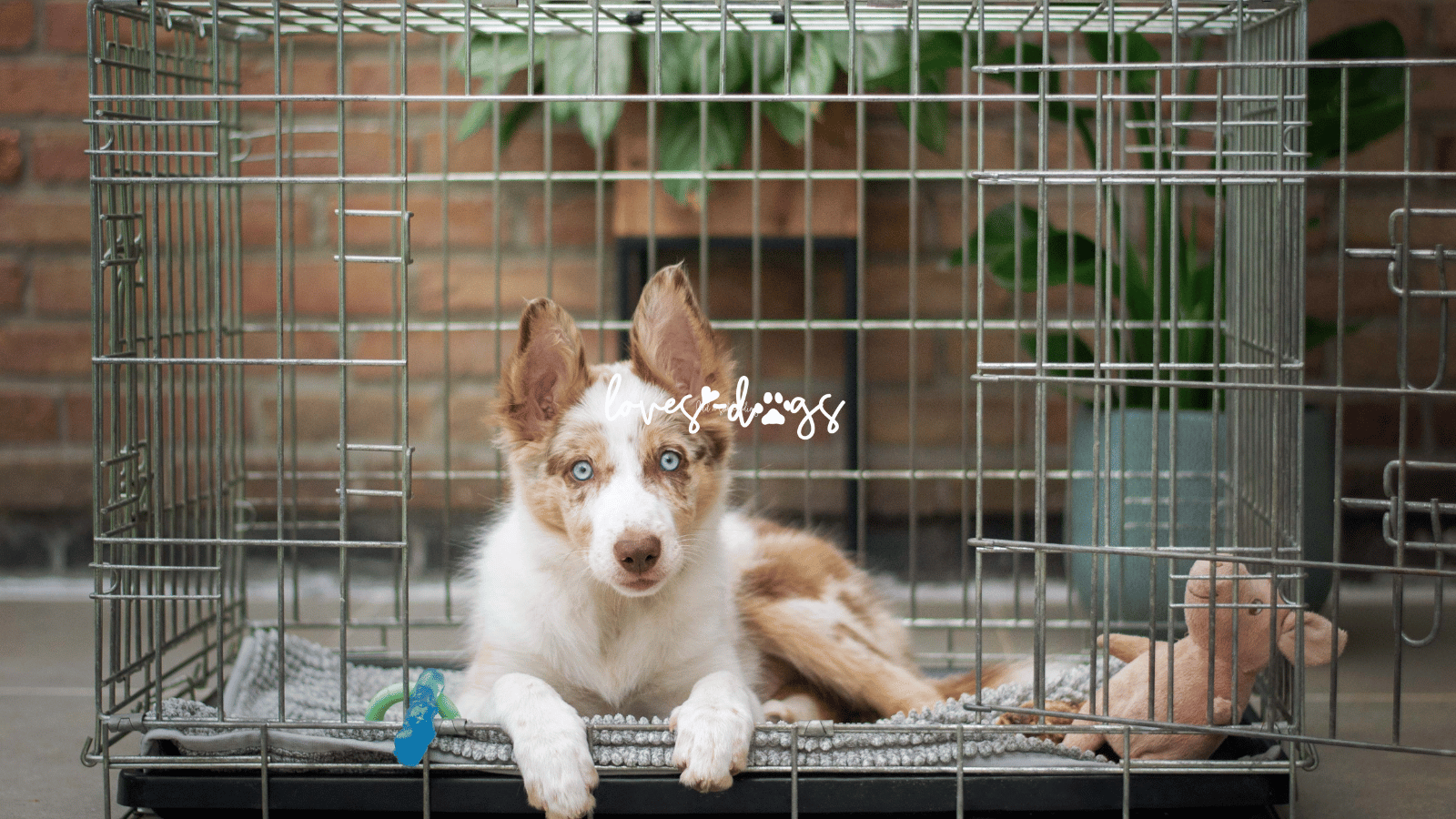
Bringing a new puppy or foster dog into your home is an exciting and rewarding experience, but it also comes with its share of challenges. One of the most crucial aspects of training a young canine companion is crate training. Not only does crate training provide a safe and cozy space for your furry friend, but it also helps instill discipline and aids in housetraining. In this comprehensive guide, we’ll walk you through the process of crate training your puppy or foster dog, step-by-step. Let’s dive in!
Why Crate Training?
If crate training has ever stopped you from thinking about adopting a shelter animal or being a foster, let’s take a look at a crate from the dog’s eyes.
The crate is actually a special place for your puppy or foster dog. It’s a safe, soft, and quiet place with sweet smells and quiet sounds. Through using a crate, the dog learns–safely and quietly–about her or his environment. The dog can smell the people and other animals who live in your home, and they can see/hear the activities that go on in your home, learn when they happen, and learn how they happen. This helps them learn routines, rules, and boundaries in a safe place.
Sure, there is a (very) small percentage of dogs who demonstrate an aversion to crates, but the likelihood of you adopting or fostering a dog like that is minimal. So, don’t let that fear stop you!
The Benefits of Crate Training
- Safety and Security:
A crate offers a safe and secure space for your dog when you can’t supervise them directly. It becomes their den—a place they can retreat to and feel protected, much like a natural instinct in the wild. The crate also helps prevent access to hazardous areas or items that could be harmful to your furry companion.
- Effective Housetraining:
Crate training is a powerful tool for housetraining puppies or newly adopted dogs. Dogs instinctively avoid soiling their sleeping area, making the crate an excellent aid in housebreaking. By establishing a consistent routine of crate time and outdoor potty breaks, you can speed up the housetraining process and minimize accidents indoors.
- Reducing Separation Anxiety:
Dogs are social animals that thrive on companionship, and separation anxiety can be a common issue. A properly crate-trained dog learns to view the crate as a place of comfort, even when you’re away. This reduces stress and anxiety when they’re left alone and helps prevent destructive behaviors that may arise from anxiety.
- Preventing Destructive Behaviors:
Chewing and destructive behaviors often occur when dogs feel bored, anxious, or restless. A crate can act as a positive deterrent to these behaviors by providing a controlled and calming environment. It keeps your dog from engaging in destructive activities, protecting your belongings and ensuring their safety.
- Facilitating Travel and Safety:
Crate training prepares your dog for travel, whether it’s short car rides or long journeys. Dogs familiar with their crates find comfort in the familiar space, reducing travel stress and ensuring their safety during transportation.
- Easier Vet Visits:
Visiting the vet can be stressful for both dogs and their owners. A crate-trained dog is more cooperative during vet visits, making examinations and treatments easier for everyone involved.
- Assisting in Behavioral Management:
Crates can be valuable tools in managing various behavioral issues, such as excessive barking, hyperactivity, or territorial aggression. When used correctly, the crate provides a calm space for your dog to relax and decompress, helping them cope with behavioral challenges.
Choosing the Right Crate
Selecting the right crate for your dog is a crucial decision that can significantly impact their comfort, safety, and overall well-being. Whether you’re crate training a new puppy or providing a cozy den for your furry companion, finding the perfect crate requires some careful consideration. In this short guide, we’ll walk you through the essential factors to consider when choosing the ideal crate for your dog.
- Size Matters:
The first and most crucial aspect to consider is the size of the crate. A crate that’s too small will make your dog feel cramped and uncomfortable, while a crate that’s too large may not provide the sense of security they need. To determine the right size, measure your dog from the tip of their nose to the base of their tail and add a few inches for comfort. Ensure your dog has enough room to stand up, turn around, and lie down comfortably.
- Material and Design:
Crates come in various materials, such as plastic, wire, and soft-sided options. Each has its advantages:
- Plastic crates are sturdy and offer a den-like feel that dogs often prefer.
- Wire crates provide better visibility and ventilation, making them suitable for warmer climates.
- Soft-sided crates are lightweight and ideal for travel, but they may not be suitable for dogs who like to chew.
Consider your dog’s temperament and needs when choosing the right material and design.
- Easy Access and Cleaning:
Look for a crate with convenient access points, such as a front door that opens smoothly. Some crates may also have a top-loading option, which is useful for easily placing your dog inside when needed. Additionally, consider the ease of cleaning – a crate with a removable tray or washable materials will make maintenance a breeze.
- Safety Features:
Ensure the crate is well-constructed and free from any sharp edges or points that could harm your dog. The crate should also have secure locks to prevent accidental escapes.
- Portability:
If you travel frequently or plan to move the crate around the house, consider its portability. Some crates are foldable, lightweight, and easy to transport, making them ideal for families on the go.
- Consider Your Dog’s Needs:
Finally, keep your dog’s personality and preferences in mind. If your dog is anxious or dislikes confinement, opt for a crate with more visibility and comfort. For dogs who prefer a cozy and secure space, a plastic crate might be a better fit.
Crate Training, Step-by-Step
Let’s dive in and explore crate training, step-by-step.
Step 1: Familiarization
Begin by placing the crate in a low-traffic area of your home. Leave the crate door open and let your dog explore it at their own pace. Encourage them with gentle praise and treats when they show interest in sniffing or approaching the crate.
Step 2: Positive Association
Create positive associations with the crate by placing your dog’s favorite toys, blankets, or treats inside. These familiar scents will entice your dog to spend more time around the crate and make it a welcoming environment.
Step 3: Short and Sweet
For the initial training sessions, keep the crate introductions short. Entice your dog into the crate with treats or toys, and allow them to come out whenever they wish. Gradually extend the time spent in the crate, ensuring your dog remains comfortable and at ease.
Step 4: Mealtime in the Crate
A powerful way to build a positive connection with the crate is to feed your dog their meals inside it. Place their food bowl near the crate entrance, and as they become more comfortable, move it deeper into the crate. This reinforces the idea that the crate is a rewarding and secure space.
Step 5: Closing the Door
Once your dog is comfortable being inside the crate with the door open, start closing the door for short periods while you are present. Stay nearby, offering soothing words or gentle petting to provide reassurance.
Step 6: Gradual Increase in Time
Over time, increase the duration of time with the door closed, while remaining attentive to your dog’s comfort level. If they seem anxious or stressed, take a step back and proceed at a slower pace. The goal is to create a sense of security and trust, not to rush the process.
Step 7: Alone Time
As your dog becomes more at ease in the crate, begin leaving them alone for short intervals. Start with brief absences and gradually extend the time as they grow accustomed to being alone in their safe space.
Step 8: Positive Reinforcement
Throughout the gradual crate training process, use positive reinforcement consistently. Praise and reward your dog for good behavior and calmness inside the crate, reinforcing their positive association with the space.
Nighttime Crate Training
Crate training at night takes a similar form as its daytime counterpart, and an established routine and positive reinforcement are key.
- Establish a consistent bedtime routine that includes leading your dog into the crate as part of the pre-sleep ritual, offering treats or toys to create a positive association.
- Place the crate near your bed during the initial stages of nighttime crate training, providing a sense of security knowing you are nearby.
- Gradually move the crate to its intended location over time, whether in another room or a specific corner of your bedroom, to help your dog adjust to the new sleeping arrangement.
Troubleshooting Common Challenges
Crate training challenges are not uncommon, but with patience, consistency, and a positive approach, they can be overcome. Let’s walk through some of the most common challenges.
- Issue: Whining and Barking
Whining and barking are common behaviors exhibited by dogs when they’re first introduced to the crate. This vocal protest might be your dog’s way of expressing discomfort or anxiety.
Solution:
- Stay patient and avoid reacting to the whining or barking. Responding may inadvertently reinforce the behavior.
- Create positive associations with the crate by placing treats or toys inside, encouraging your dog to enter willingly.
- Gradually increase crate time and ensure your dog receives plenty of exercise and mental stimulation before crate sessions, reducing restlessness.
- Issue: Separation Anxiety
Dogs are social animals, and crate training may trigger separation anxiety in some cases, leading to excessive distress and destructive behavior.
Solution:
- Start crate training in short intervals while you’re present, gradually extending the time you spend away from your dog.
- Leave your dog with an item that bears your scent, such as a shirt you’ve worn, to provide comfort during your absence.
- Consider using calming aids like puzzle toys or calming music to soothe your dog during crate time.
- Issue: Refusal to Enter the Crate
If your dog flat-out refuses to enter the crate, it may indicate a negative association with the space.
Solution:
- Never force your dog into the crate, as it will only increase their resistance.
- Make the crate inviting by using positive reinforcement techniques. Place treats, toys, or their favorite blanket inside to entice them.
- Use mealtime as an opportunity to build positive associations with the crate. Feed your dog inside the crate, associating it with something enjoyable.
- Issue: Accidents Inside the Crate
Accidents inside the crate can be disheartening, especially if you’re using crate training for housetraining.
Solution:
- Ensure your dog has had ample opportunities to go potty before crate time.
- Never scold your dog for accidents inside the crate, as it may create a negative association.
- Adjust the crate size if needed; too much space can lead to a corner being used for elimination.
Get Everyone Off on the Right Foot (or Paw!)
Crate training your puppy or foster dog is a valuable investment of time and effort. It lays the foundation for a well-behaved and confident companion. Remember to be patient, use positive reinforcement, and tailor the training to your dog’s unique needs. With time, consistency, and love, you’ll create a positive and lasting relationship with your four-legged family member or foster.
Photo by Ayla Verschueren on Unsplash









Find Loves Dogs on Social